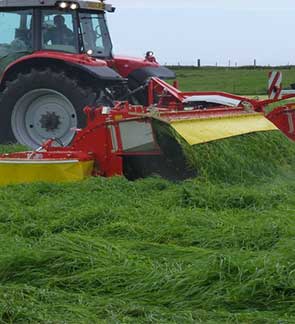IDEAL NITROMO High Protein
18% Intermediate Perennial Ryegrass, Tetraploid, 24% Hybrid Ryegrass, Tetraploid, 20% Intermediate Perennial Ryegrass, Diploid, 15% Festulolium Ryegrass 20% Intermediate Red Clover, 3% Large White Clover
Why are more farmers returning to RED CLOVER mixtures?
There are a growing number of farmers now seeking to reduce the cost of production by using less fertiliser and by reducing the amount of purchased feed. It is predicted that many dairy, beef and sheep farmers will choose to grow high clover leys and adopt a lower cost production system. High Red clover leys require little or no nitrogen fertiliser and provide an excellent source of protein. Whilst there are many benefits from clover leys.
Why Red clover?
Red clover grown in forage seed mixtures offer a cheap alternative to nitrogen fertiliser and provides a homegrown source of protein. Clover plants are able to extract nitrogen from the air, which itself is three quarters nitrogen, indirectly into the soil via bacteria in nodules on plan roots.
There are also concerns about the effects of increasing diesel costs which affect the very application of fertiliser itself. Coupled with this is the burden of record keeping and even the disposal of polypropylene and plastic bags. Finally, NVZ regulations mean that grass farmers will be restricted by a further reduction of 30kgN per hectare.
Digestibility and palatability
Clovers are more digestible than grass and this is one reason why livestock perform well when fed clover. Clovers are extremely palatable to sheep and cattle. This is important as it enables productive animals to consume more forage. More forage intake with a high protein content leads to greater live weight gain and milk yields.
Red clover is for silage
This has a high yield of around 15t DM/ha and is most commonly used for silage production. It is an upright plant which can yield up to 30% more than white clover. Red clover leys are cut for silage at the end of May. Two or three more cuts follow throughout the summer and autumn.
Red clover silage has a crude protein content of 16% to 20% and a ME content of 10 to 12MJ/kg DM Store/fat lambs can be fattened very effectively on red clover silage.
Note: High in Phyto-oestrogen, breeding sheep should be kept off for six weeks
 SALEQuick ViewIDEAL MULTIMO Silage & Graze 35% Hybrid Ryegrass, Tetraploid, 50% Intermediate Perennial Ryegrass, 15% Festulolium Ryegrass Tetraploid hybrids grow well on their own, although do present a slightly open sward. The Seasonal growth of the sward is vastly improved by growing a combination of hybrid varieties with Diploid Perennial Ryegrass forming a tight sward base particularly in the critical mid-season period to maintain production and minimise weed invasion Hybrids give good yield in early spring, in the critical mid-season period, and in the autumn for extended grazing seasons. MULTIMO will also maintain high yields of good quality silage extending into the fourth harvest year. When to cut: Up to four cuts per year May, July, August and October. This is the ultimate medium-term silage mixture, yielding up to 16t DM/ha in its first cut and easily last up to four years.
SALEQuick ViewIDEAL MULTIMO Silage & Graze 35% Hybrid Ryegrass, Tetraploid, 50% Intermediate Perennial Ryegrass, 15% Festulolium Ryegrass Tetraploid hybrids grow well on their own, although do present a slightly open sward. The Seasonal growth of the sward is vastly improved by growing a combination of hybrid varieties with Diploid Perennial Ryegrass forming a tight sward base particularly in the critical mid-season period to maintain production and minimise weed invasion Hybrids give good yield in early spring, in the critical mid-season period, and in the autumn for extended grazing seasons. MULTIMO will also maintain high yields of good quality silage extending into the fourth harvest year. When to cut: Up to four cuts per year May, July, August and October. This is the ultimate medium-term silage mixture, yielding up to 16t DM/ha in its first cut and easily last up to four years. SALEQuick ViewIDEAL NITROMO High Protein 18% Intermediate Perennial Ryegrass, Tetraploid, 24% Hybrid Ryegrass, Tetraploid, 20% Intermediate Perennial Ryegrass, Diploid, 15% Festulolium Ryegrass 20% Intermediate Red Clover, 3% Large White Clover
SALEQuick ViewIDEAL NITROMO High Protein 18% Intermediate Perennial Ryegrass, Tetraploid, 24% Hybrid Ryegrass, Tetraploid, 20% Intermediate Perennial Ryegrass, Diploid, 15% Festulolium Ryegrass 20% Intermediate Red Clover, 3% Large White Clover

